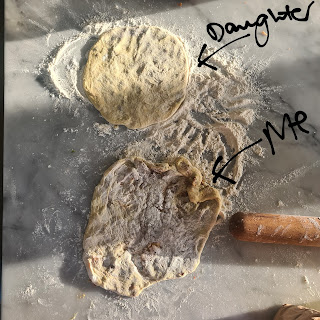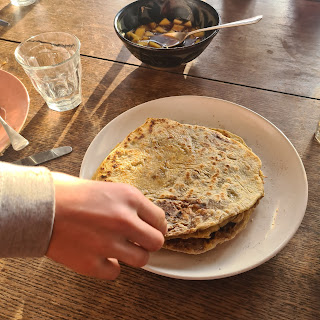Cooking through the year's festivals
My friends and family know that what I really love more than anything is food and cooking. The holiday period was a time to cook away at all sorts of meals for different occasions, plus I was given three cookbooks for Christmas. Two of these were Claudia Roden's classics - her Book of Middle Eastern Food and the Book of Jewish Food - which, as well as being full of wonderful recipes to try - are also cultural histories of those food traditions, interpreting centuries of change, trade, repression, poverty and wealth through spices, techniques, food combinations and food stories. I read these books a long time ago, when my parents got them, and I was so glad to have my own copies and to immerse myself again in Roden's wonderful scholarship, and her love for how food reflects and shapes culture.
Reading about the foods associated with important moments in the year - festivals, anniversaries, seasons - I made mental notes to try out some of these recipes at the appropriate moments. Coming out of a holiday period where food is so central and celebratory, I started to think about all the other food cultures and how they mark their important annual moments. Perhaps I could cook the foods associated with other traditions too, as a way to expand my repertoire of dishes as well as learning about those cultures of which my understanding is too superficial. I marked up a spare calendar with as many festival and feast days as I could google, and we've started to cook our way through them. Here's a bit about what we cooked this week. I am sure I got some things very wrong, so I'd love to hear what and how you cook for these festivals - and of course, for the many high and holy days coming up through the year.
1. Kutya - Orthodox Christmas
Kutya (or kutia) is a kind of grain porridge with dried fruits, poppyseed, honey and nuts, traditional to Ukraine and with variants common from Belarus in the north down to Greece and Sicily in the south. It is found in the Orthodox Christian traditions only - in Sicily, likely a leftover from the Byzantine occupation as it is found nowhere else in Italy. This is a food that may date back to Neolithic times - an ornamented version of what would have been the daily staple food of barley or wheat porridge. Apparently it is a food which you might ritually exchange with family and friends, and leave out as an offering to ancestors, as well as throwing it at the ceiling to see if it stuck, in which case you would have a good harvest - rituals which point to ancient, pre-Christian roots.
We had it for breakfast on the 7th although really it should have been the first course in a 12-course Christmas Eve meal. Lacking wheatberries, I used a mix of pearl barley and brown rice - as the dish also reminded me of both an English rice pudding (which itself is an interpretation of the sweetened rice dishes of the Middle East and Arab Spain) as well as Japanese rice porridges from my childhood. It was pretty good, although I could have had it with just nuts and honey and no raisins - doubling up on the sweetness felt a bit unnecessary.
2. Fattah - Coptic Christmas
The Coptic church has good claim to be more ancient than any other existing branch of Christianity and, like the Orthodox church, it celebrates Christmas on the 7th January. The Ethiopian Copts are one of the sects that lay claim to part of the Church of the Holy Sepulchre in Jerusalem - and they have the roof, which they have made into the perfect quiet, secluded monastery where I used to spend a lot of time when I was researching in the city back in my university days. In tribute to those lovely monks and their rooftop life, peering down through the lanterns of the domes into the church, I considered learning to make injera and to go all out with a full Ethopian meal - but life intervened, so instead I made an Egyptian fattah, which, again, is a basic, everyday food elevated on feast days, like Christmas, with meat and additional garnishes. One of our kids is vegetarian so I made it with aubergine and pumpkin instead.
Fattah uses leftover pitta or flatbread, toasted into crisps, as the base on top of which various toppings, almost always with a yoghurt sauce, are piled. It is found in variants and different pronunciations across North Africa and the Levant - the fattoush of Lebanon is another example - and is a classic frugal food from a culture where flatbreads would be made daily and there would always be leftovers not to be wasted. We piled ours with rice, a yoghurt and tahini sauce, the aubergine and pumpkin cooked with onions and spices, and a lightly spiced tomato sauce which soaks into the rice and bread, and topped with pomegranate seeds, pine nuts toasted in clarified butter, and chopped parsley. It was beautiful and delicious, and we finished the platter.
3. Pulihore rice, ugadi pachadi and holige - for Guru Gobind Singh's birthday
Guru Gobindh Singh is the tenth guru and a major figure in Sikhism who lived in the late 17th and early 18th century. Finding out about what foods might be associated with this important day sent me down a rabbit warren of research and I'm expecting someone to tell me I got it all wrong. It was relatively clear that the day is celebrated with rituals and visits to the Gurdwara but not altogether clear what food was involved. I went with the Times of India's suggestions of pulihore rice, ugadi pachadi and holige, each of which then needed a lot more research to understand how they were made.
Pulihore rice (or puligoyara rice or many other transliterated spellings) is rice dressed with a thick sauce based on tamarind pulp and jaggery, an unrefined form of sugar, along with various spices. There are about as many versions of this as you would expect from a country as large and varied as India, but the basics seemed to be that the rice should be cooked and cooled before it is dressed, and that peanuts are added in which bring texture as well as protein to the dish. It is known as a 'temple rice' which would be prepared and given out to the poor at temples on feast days, and also as a rice for taking on long journeys, because it can keep for many days without spoiling. This must have to do with the combination of the sour acid of tamarind along with sugar, which act as a preservative - the same principle as sushi rice which is also dressed with a sugar-acid combination and was a way to preserve cooked rice.
Like the Ukrainian kutya, this is staple food made special without adding many expensive ingredients. Apparently you can make large quantities of the sauce and keep it for dressing rice as and when you want to make the dish. The sauce was incredibly delicious, though I should have used slightly more sauce to slightly less rice when I dressed it, as it ended up a little under-seasoned when assembled. But altogether something I would definitely repeat.
Ugadi pachadi is a kind of food for which English doesn't have a word. It's a drink but also food, and highly symbolic in the ingredients, which are meant to symbolise the six emotions of life: sweet, from jaggery, representing joy or happiness; sour, from tamarind, representing unpleasantness or disgust; tangy unripe mango symbolising surprise; bitter neem flowers for sadness; spicy chilli or black pepper for anger; and salt for fear. It's traditional for New Year in some states, and the ingredients also have significance from an Ayurvedic health perspective. I was certainly cautious about whether this mix of flavours would be in any way delicious or merely something to gulp down dutifully, but it was refreshing, spicy, and moreish - a great foil to the rich rice dish. We served it into glasses like a drink but I think a small round bowl with a small deep spoon would be better.
Lastly the holige - a sweet stuffed flatbread of which there are also many variants, and also an elevated version of a staple food, made special through
judicious use of cheap but aromatic ingredients and the extra effort. A soft, highly elastic dough is used to wrap a filling of sweetened, cardamom-spiced dal and coconut, and rolled out thin. Our eldest daughter proved to be the best at the making of these, managing no rips or tears in the outer layer of dough, although ours were definitely far from as thin as they should be and nowhere near the level of skill in this video. They were incredibly comforting and delicious, pretty easy if aesthetics is not the primary aim, and certainly something to make again - the filling would be a great way to use up leftover cooked chana or other dal.
Only a week and already so many new foods, new stories, reflections and learning. I might not keep this up for long but even a few dives into these different food cultures brings up a lot. I am much more familiar with European, Middle Eastern and Japanese traditions than any others, so I would love to know what feast days you celebrate and what foods you make for them. Please leave a comment!





Comments